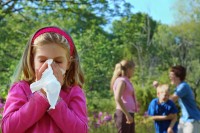School is about to begin (sigh) and parents all around the world are worrying about how allergies will cause problems with their children. This year’s late spring and prolonged heat wave are going to make it worse.
It happens every year like clockwork. Right after school begins, when kindergartners and first graders pull out their mats and rugs at quiet time, there is a spate of dust-induced asthma and rhinitis.
When leaves start falling, mold spores begin to increase both indoors and out. Fall and winter-time air-temperature inversions—warm air on top of cold—occur both inside and out. This decreases the vertical mixing of air, and contaminants build up as a result.
When building custodians fire up the furnaces, dust and mouse droppings that have accumulated all spring and summer are swept right out of the heating ducts, into the classroom and the air everyone is exposed to.
Add to the normal everyday allergen-laden super-market of dust, dirt, chalk, pollen, pesticides, chemicals, sanitation supplies, perfumes, guinea pigs, mice, birds, rodents, and cockroaches — all make schools a 24-hour-a-day, year-round threat.
What can an allergy Moms and Dads do? Paul Ehrlich, MD and Larry Chiamonte, MD are the authors of Asthma, Allergies and Children: A Parent’s Guide. Here is their checklist for parents for the start of the school year.
1. Find out who staffs the health clinic. Do they know how to administer a metered-dose inhaler or nebulizer treatment for your child? Do they have policies and procedures about food allergies, particularly peanuts? Do they regulate snacks and special-occasion treats such as birthday cupcakes?
2. Find out if school policy allows students to carry medication. If your child is old enough, make sure she knows how to use her medications. If students aren’t permitted to carry medication, make sure the school staff knows where the medication is stored and how to administer it properly.
3. Let the school know how to reach you during the day in case of an emergency.
4. Tour your child’s classroom before school starts to identify potential allergy and asthma triggers. Offer suggestions to protect your child’s health.
5. If your child has exercise-induced asthma, talk to the school and staff responsible and make sure coaches and physical education teachers know the warning signs that your child is likely to experience and how to handle an emergency if one occurs.
6. Work with your child’s teacher. When a child is itchy or having trouble breathing, it’s hard to concentrate; certain over-the-counter and prescription medicines can make them moody and impact their ability to learn. Work with your child’s teacher to develop ways to help your child focus.
7. Keep lines of communication with the school open throughout the year. Review your management plan periodically and make sure everyone is comfortable with the strategies in place.
If your child is athletic and has asthma there are a few extra precautions you can take. Have your child run a few laps in a warm gym before going outside. This helps avoid cold air shock which causes bronchospasm. You might also ask your doctor about a medicine called a beta-agonist spray twenty minutes before exercise. There is no need to worry about exercising. Elite athletes who have overcome asthma to become champions, include soccer player David Beckham, Olympic Gold Medal skater Kristy Yamaguchi and Olympic swimmer Mark Spitz.
The bottom line? The most important thing that parents can do if they need help is to see an allergy specialist. Get a referral or get an appointment, do whatever it takes. Seeing a specialist is to best way to make sure your child gets the best and most effective treatment.
For more information visit www.AsthmaAllergiesChildren.com
